Published: March 29, 2022
Updated: May 6, 2025
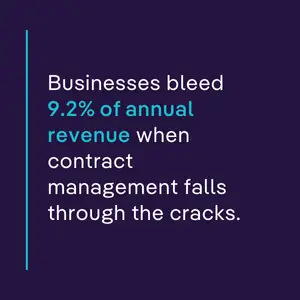
In today’s complex business environment, the ability to effectively manage contracts throughout their lifecycle is no longer optional—it’s a competitive necessity. Yet many organizations struggle to quantify and optimize their contract management processes, often relying on gut feelings rather than concrete metrics.
The average company loses 9.2% of its annual revenue due to poor contract management, according to World Commerce & Contracting. This revenue leakage stems from missed obligations, inefficient processes, and opportunities left on the negotiation table.
For legal teams, procurement professionals, and contract administrators, establishing the right Key Performance Indicators (KPIs) creates visibility, accountability, and continuous improvement. But which metrics truly matter? And how can you leverage them to transform your contract operations?
This guide explores the essential contract management KPIs your team should be tracking, providing actionable insights to elevate your contract management strategy from reactive to proactive.
Why Contract Management KPIs Matter
Contract management KPIs serve as the compass for your contract operations, helping you navigate between current performance and desired outcomes. Without concrete measurements, you’re essentially flying blind.
The Business Case for Contract Management Metrics
Contract management metrics deliver multiple benefits across your organization:
- Risk Mitigation: Identify compliance issues before they become costly problems
- Resource Optimization: Deploy your legal and procurement talent where they add the most value
- Process Improvement: Pinpoint bottlenecks and inefficiencies in your contract workflows
- Performance Tracking: Hold teams accountable for contract-related outcomes
- ROI Demonstration: Quantify the business impact of your contract management initiatives
Essential Contract Management KPIs to Track
Contract management KPIs typically fall into four key categories: efficiency, performance, risk, and compliance. Let’s examine the most impactful metrics in each area.
1. Process Efficiency KPIs
These metrics measure how efficiently your team creates, reviews, negotiates, and executes contracts.
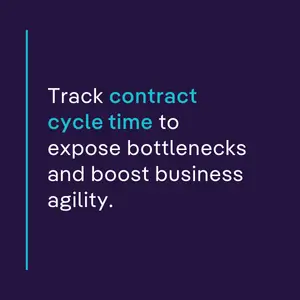
Contract Cycle Time
What it measures: The total time from contract request to execution
Why it matters: Extended cycle times often indicate process inefficiencies, resource constraints, or approval bottlenecks. They also impact business agility and customer/vendor relationships.
How to track it:
Measure the average number of days from initial request to final signature. For deeper insights, break this down by:
- Contract type (sales, procurement, employment, etc.)
- Contract value/complexity
- Department or business unit
Improvement strategies:
- Implement standardized templates with pre-approved language
- Create contract request forms that capture all necessary information upfront
- Establish automated workflow routing and approval pathways
- Deploy AI-powered contract review technology to accelerate legal review
Time-to-Approval by Stage
What it measures: The time spent in each phase of the contract lifecycle
Why it matters: This granular view helps pinpoint specific bottlenecks in your process.
How to track it:
Measure time spent in:
- Initial drafting
- Internal review cycles
- Legal review
- Negotiation with counterparties
- Approval workflows
- Signature collection
Improvement strategies:
- Create SLAs for each review stage
- Implement escalation procedures for stalled contracts
- Provide self-service options for low-risk, routine contracts
First-Time Acceptance Rate
What it measures: The percentage of contracts accepted by counterparties without revisions
Why it matters: Low acceptance rates indicate potential issues with standard terms, pricing models, or negotiation approaches.
How to track it: (Number of contracts accepted without changes ÷ Total contracts sent) × 100
Improvement strategies:
- Review frequently negotiated clauses and consider revising standard terms
- Create fall-back positions for commonly contested provisions
- Implement playbooks to guide negotiation strategy
2. Contract Performance KPIs
These metrics measure the business outcomes and value delivered through your contracts.
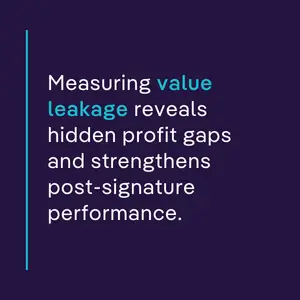
Contract Value Leakage
What it measures: The difference between expected contract value and actual realized value
Why it matters: Value leakage directly impacts financial performance and ROI.
How to track it:
Monitor:
- Pricing/discount compliance
- Volume commitment attainment
- Missed entitlements (rebates, bonuses, etc.)
- Service level agreement compliance
Improvement strategies:
- Implement automated alerts for key milestones and obligations
- Conduct quarterly contract performance reviews
- Build a centralized obligation management system
Cost Avoidance/Savings
What it measures: The financial impact of effective contract negotiations and management
Why it matters: Demonstrates the tangible ROI of your contract management function
How to track it:
Calculate:
- Negotiated savings vs. initial offers
- Value of avoided penalties
- Benefits from early payment discounts
- Cost reduction from standardized terms
Improvement strategies:
- Implement AI-powered obligation extraction and tracking
- Create standardized reporting on savings metrics
- Establish a contract savings dashboard for executive visibility
Renewal Rates and Timing
What it measures: The percentage of eligible contracts renewed and how far in advance renewals are completed
Why it matters: High renewal rates indicate satisfied counterparties and effective contract value delivery. Early renewals reduce risk and capture continued value.
How to track it:
- Renewal rate: (Number of renewed contracts ÷ Total eligible for renewal) × 100
- Renewal timing: Average days before expiration that renewals are completed
Improvement strategies:
- Implement automated renewal reminders (90-60-30 days before expiration)
- Create a renewal risk assessment framework
- Establish a cross-functional renewal team for high-value contracts
3. Risk Management KPIs
These metrics help identify, quantify, and mitigate contractual risks.
Contract Risk Score Distribution
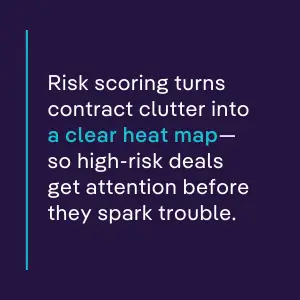
What it measures: The risk profile of your contract portfolio
Why it matters: Helps prioritize monitoring and management resources toward higher-risk agreements
How to track it:
Categorize contracts by risk level (high/medium/low) based on:
- Value/financial impact
- Regulatory implications
- Indemnification provisions
- Data privacy/security requirements
- Termination conditions
- Force majeure provisions
Improvement strategies:
- Implement standardized risk scoring methodology
- Conduct quarterly reviews of high-risk contracts
- Create automated alerts for risk-triggering events
Non-Standard Term Frequency
What it measures: The percentage of contracts containing deviations from standard language
Why it matters: Frequent deviations increase risk exposure and complicate compliance monitoring
How to track it: (Number of contracts with non-standard terms ÷ Total contracts) × 100
Improvement strategies:
- Implement clause libraries with approved alternatives
- Require approval workflows for non-standard terms
- Track negotiation patterns to identify opportunities for template updates
Dispute Resolution Metrics
What it measures: The frequency, resolution time, and financial impact of contract disputes
Why it matters: Contract disputes indicate potential issues with clarity, compliance, or relationship management
How to track it:
- Number of disputes per time period
- Average time to resolution
- Financial impact of disputes
- Root causes of disputes
Improvement strategies:
- Analyze dispute patterns to proactively address common issues
- Create escalation procedures for potential disputes
- Implement relationship management protocols for high-value contracts
4. Compliance and Governance KPIs
These metrics ensure contracts meet internal policies and external regulatory requirements.
Regulatory Compliance Rate
What it measures: The percentage of contracts adhering to applicable regulations
Why it matters: Non-compliant contracts expose the organization to significant legal and financial risks
How to track it:
- Audit results (internal and external)
- Compliance exceptions by type
- Remediation completion rates
Improvement strategies:
- Implement automated compliance screening during contract creation
- Create regulatory change management procedures
- Develop compliance certification workflows
Obligation Fulfillment Rate
What it measures: The percentage of contractual obligations met on time
Why it matters: Missed obligations lead to penalties, relationship damage, and potential litigation
How to track it: (Number of obligations fulfilled on time ÷ Total obligations due) × 100
Improvement strategies:
- Implement automated obligation extraction and tracking
- Create cross-functional accountability for obligation fulfillment
- Establish obligation risk scoring to prioritize monitoring
Contract Accessibility and Completeness
What it measures: The percentage of contracts stored in your central repository with complete metadata
Why it matters: Inaccessible or incomplete contracts create significant operational and compliance risks
How to track it:
- Repository coverage: (Contracts in system ÷ Total known contracts) × 100
- Metadata completion rate
- Supporting document linkage rate
Improvement strategies:
- Implement bulk migration of legacy contracts
- Create mandatory metadata fields for all new contracts
- Conduct periodic repository audits
Setting SMART Goals for Contract Management Success
While tracking KPIs provides visibility into your contract management performance, translating those insights into actionable improvements requires structured goal-setting. This is where SMART goals become essential for contract management excellence.
Why SMART Goals Matter for Contract Managers
Contract managers face unique challenges including compliance risks, missed deadlines, and inefficient workflows. The SMART framework (Specific, Measurable, Achievable, Relevant, Time-bound) provides the structure needed to:
- Minimize risks by creating clear accountability for compliance and obligation management
- Improve efficiency by establishing concrete process improvement targets
- Optimize contract value by focusing teams on financial and performance outcomes
- Drive adoption of AI and automation tools with clear implementation milestones
Breaking Down SMART Goals for Contract Management
Let’s examine how each element of the SMART framework applies to contract management in the graphic below:
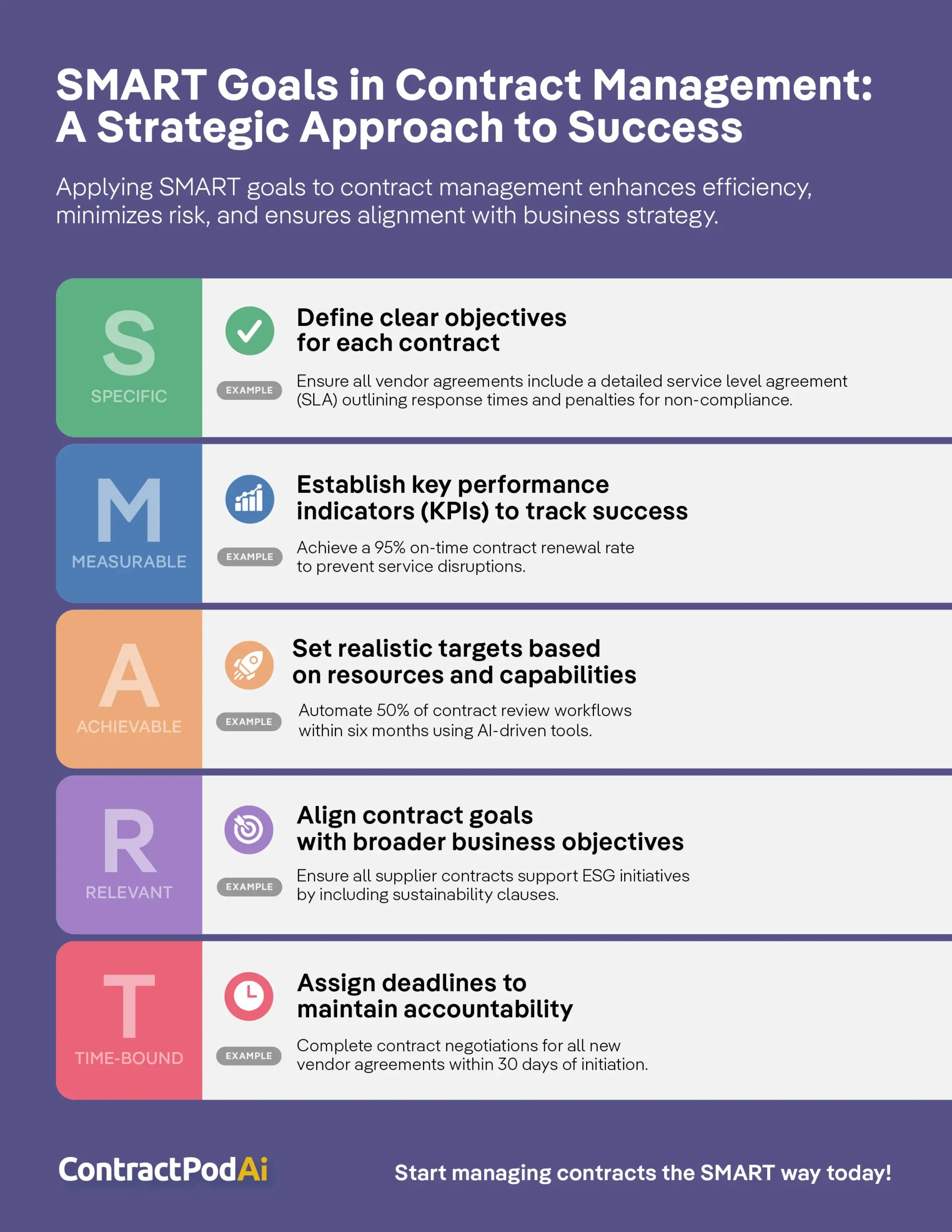
AI-Powered SMART Goal Strategies for Contract Managers
Modern contract management leverages AI and automation to achieve ambitious goals more efficiently. Here’s how AI can support your SMART goal implementation:
Strategy 1: Use AI for Performance Baseline Establishment
Before setting targets, use AI-powered analytics to understand your current performance:
- Analyze historical contract cycle times across different agreement types
- Identify common bottlenecks and their frequency
- Quantify current value leakage and its root causes
- Assess current risk and compliance status
Strategy 2: Leverage AI for Continuous Progress Monitoring
AI can automatically track progress toward SMART goals without manual data collection:
- Real-time dashboards showing goal attainment percentages
- Automated alerts when progress deviates from expected trajectory
- Predictive analytics forecasting likely goal achievement based on current trends
Strategy 3: Implement AI-Driven Goal Refinement
As you work toward your goals, AI can help identify opportunities for refinement:
- Suggest more achievable targets based on performance patterns
- Identify additional sub-goals that support primary objectives
- Recommend process changes based on successful patterns
Creating Your Own SMART Goals: Practical Framework
Follow this step-by-step process to develop effective SMART goals for your contract management function:
- Assess Current State: Use your KPI data to identify your biggest performance gaps and opportunities
- Prioritize Impact Areas: Focus on goals that align with organizational priorities and offer the highest ROI
- Define Success Metrics: Establish clear measurements that indicate goal achievement
- Set Realistic Timeframes: Balance ambition with achievability in your deadlines
- Assign Ownership: Create clear accountability for goal attainment
- Establish Tracking Mechanisms: Determine how and when progress will be measured
- Create Supporting Action Plans: Break each goal into specific implementation steps
Pro Tip: Create a goal hierarchy with 2-3 primary goals supported by more specific sub-goals. For example, a primary goal of “Reduce average contract cycle time by 40% within 6 months” might be supported by sub-goals for different contract types or process stages.
Implementing an Effective KPI Framework
Establishing the right metrics is only the first step. To create lasting value, you need a comprehensive approach to contract management KPIs.
1. Align KPIs with Business Objectives
Contract management metrics should directly support organizational goals:
| Business Objective | Supporting Contract KPIs |
|---|---|
| Revenue Growth | • Contract cycle time • Renewal rates • Cross-selling/upselling rates |
| Cost Reduction | • Negotiated savings • Process efficiency metrics • Template utilization rates |
| Risk Mitigation | • Risk score distribution • Compliance rates • Obligation fulfillment |
| Customer Satisfaction | • Renewal rates • Dispute frequency • SLA compliance |
2. Build a Contract Intelligence Dashboard
Modern contract management requires real-time visibility. A well-designed dashboard should include:
- Executive View: High-level metrics aligned with business objectives
- Operational View: Day-to-day performance and workload metrics
- Risk View: Compliance status and risk exposure indicators
- Trend Analysis: Performance over time with forecasting capabilities
3. Leverage AI for Advanced Contract Analytics
Traditional contract management systems struggle with the unstructured data in contracts. AI-powered solutions like ContractPodAi enable:
- Automated Obligation Extraction: Identify and track commitments without manual review
- Risk Pattern Recognition: Identify concerning patterns before they become problems
- Performance Prediction: Forecast renewal probability and value leakage risk
- Benchmark Comparison: Compare your performance against industry standards
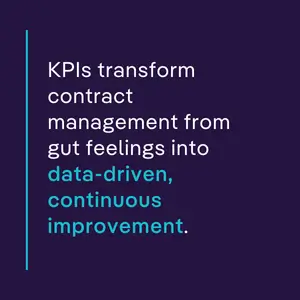
4. Establish a Continuous Improvement Loop
The most effective contract management programs use KPIs to drive ongoing optimization:
- Measure current performance against established baselines
- Analyze root causes of performance gaps
- Implement targeted process improvements
- Monitor impact on key metrics
- Refine approaches based on outcomes
Common Pitfalls in Contract Management Measurement
Avoid these common mistakes when implementing your KPI framework:
1. Measuring Too Much
The problem: Tracking dozens of metrics creates information overload and dilutes focus.
The solution: Start with 5-7 core KPIs aligned with your most critical business objectives. Add additional metrics only when you’ve mastered the basics.
2. Focusing on Volume Instead of Value
The problem: Emphasizing contract counts and processing speeds without considering business outcomes.
The solution: Balance efficiency metrics with impact metrics like value leakage, risk reduction, and business enablement.
3. Ignoring Leading Indicators
The problem: Concentrating exclusively on lagging indicators that reveal problems after they occur.
The solution: Implement predictive metrics that identify potential issues before they impact performance:
- Template deviation trends
- Approval bottleneck patterns
- Negotiation duration by counterparty
4. Failing to Create Accountability
The problem: Measuring performance without clear ownership and consequences.
The solution: Assign specific KPI ownership to team members and integrate contract performance into relevant roles’ objectives.
Building Your Contract Management KPI Action Plan
Ready to transform your contract management approach with data-driven insights? Follow this step-by-step implementation roadmap:
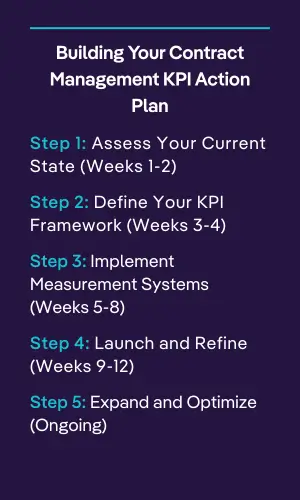
Step 1: Assess Your Current State (Weeks 1-2)
- Inventory existing metrics and reporting capabilities
- Identify key stakeholders and their information needs
- Document current performance baselines where available
Step 2: Define Your KPI Framework (Weeks 3-4)
- Select 5-7 core metrics aligned with business priorities
- Define calculation methodologies and data sources
- Establish initial targets based on industry benchmarks or internal goals
Step 3: Implement Measurement Systems (Weeks 5-8)
- Configure your contract management system for KPI tracking
- Develop reporting dashboards for different user groups
- Create data collection procedures for metrics requiring manual input
Step 4: Launch and Refine (Weeks 9-12)
- Begin regular reporting and review cadence
- Gather user feedback on metric relevance and actionability
- Adjust metrics and targets based on initial findings
Step 5: Expand and Optimize (Ongoing)
- Add additional metrics as core KPIs become established
- Implement more sophisticated analysis techniques
- Continuously align metrics with evolving business objectives
In Summary: From Measurement to Management Excellence
Implementing the right contract management KPIs transforms contracts from static documents into strategic assets. By measuring what matters and setting SMART goals based on those metrics, you create visibility, accountability, and continuous improvement throughout the contract lifecycle.
The organizations that excel at contract management don’t just collect metrics—they use them to drive meaningful change through structured goal-setting and focused execution. They understand that the goal isn’t measurement for its own sake, but rather creating visibility that enables better decisions and outcomes.
As your contract management capabilities mature, your KPI approach should evolve as well—moving from basic operational metrics to sophisticated predictive analytics that help you anticipate challenges and capitalize on opportunities.
Ready to transform your contract management approach with data-driven insights? ContractPodAi’s AI-powered contract management platform provides built-in analytics and dashboards to help you measure what matters, set achievable goals, and drive continuous improvement.
Let ContractPodAI help unlock the potential of your contract management process and explore how we can help you achieve your contract management goals with AI-powered solutions. Schedule a demo today.


